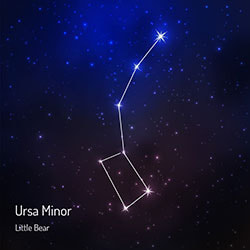 Hello again from the Observatory on St Martin’s. It’s been a little longer than usual since my last update on the night sky. The reason for that is the arrival of our baby, whom we’ve called Teddy, a month early! He was born just before the New Moon in September, so the astronomer in me would like to think he knew it was the right time to get out there and stargaze. In any case, in honour of Teddy, I thought I’d talk about the other little bear in my life, the one in the sky: Ursa Minor. We will be more familiar with Ursa Major, the great bear, and especially the main pattern within it that’s nicknamed the Plough. Or the big dipper in the USr , or – my preferred – the saucepan, in France. Visible all year, Ursa Major is one of the Northern Hemisphere’s great waymarkers of the sky. It’s what’s called a ‘circumpolar constellation’, meaning it rotates round the northern celestial pole. In practicality, that means its place in the sky changes throughout the year – it won’t always look the same way up! It’s a really good one to make yourself familiar with – find one familiar constellation and you will soon begin to learn many more. Located within a celestial stone’s throw of the Plough is Ursa Minor, the small bear, also known as the little dipper. Its alpha star, Polaris, gives Ursa Minor its importance, because it’s actually a fairly faint constellation in the grand scheme of things. Polaris is the North Star, or Pole Star, so known because it’s located within one degree of the celestial North Pole. This makes it a very good one for navigating by the stars. Because it’s so well known, many expect the Pole Star to be brighter than it is. It’s actually only a magnitude 2 star (less bright than the three brightest stars in the Plough). Polaris is, we reckon, 680 light years from us and 6000 times as bright luminous as the Sun. (So actually, that makes it very bright indeed, we’re just quite far away!) You can find Polaris by extending your gaze up past the 2 right hand side of the plough by 5 times the distance between those 2 stars. Polaris forms the tail of the little bear. The pattern of Ursa Minor looks like a slightly dim and distorted back-to-front version of the Plough. The other notable star in the constellation is Kochab, at the other end of Ursa Minor to Polaris. Kochab’s got a nice orangey colour, which makes it a good contrast with more white-looking Polaris. Have a go with the naked eye and see if you can become as familiar locating the little bear as its big neighbour. The Observatory on St Martin’s is now closed for the season – our Tuesday night and Friday afternoon open sessions will be back in April. That said, if you’re on the island and would like to drop in, do get in touch and if we’re around we’ll be happy to open up for you. Otherwise, we’re taking this Winter to get more familiar with the kit and hopefully to get lots more super dark sky images to share with you. Watch this space, as they say!
0 Comments
Your comment will be posted after it is approved.
Leave a Reply. |
BYCharlie Payne POSTS
September 2024
|

 RSS Feed
RSS Feed